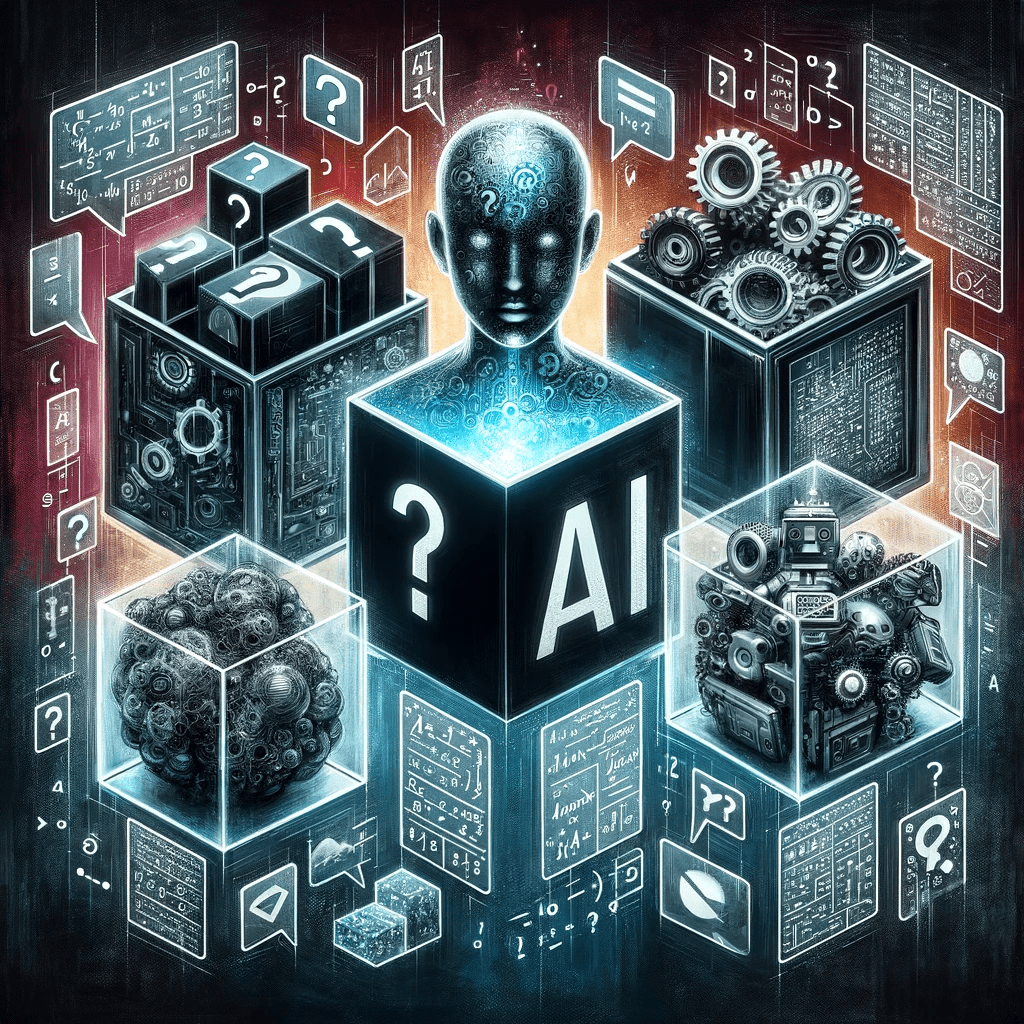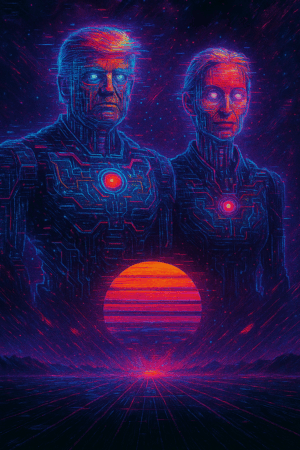Foreword
A list of AI Terms (aka buzzwords, terms you should know). Please note, if you want to read a small article about the creation of this article (yes, we write about the stuff we write you can give us a visit on Medium.com via this >Link<.
The Glossary
Algorithm
- A set of rules or procedures followed in calculations or problem-solving operations, especially by a computer.
Agent / Agents
- An autonomous entity in artificial intelligence that perceives its environment and takes actions to maximize its chances of achieving specific goals. AI agents can range from simple, rule-based systems to complex, learning-based entities capable of adapting to changing conditions. They are used in various applications, including robotics, virtual assistants, and game AI, functioning within predefined parameters to make decisions, solve problems, or interact with humans or other systems.
Anthropomorphism
- The practice of attributing human-like qualities, such as emotions, intentions, or behaviors, to artificial intelligence systems or machines. This can include designing AI with human-like appearances or interactions, making them more relatable or easier for humans to engage with. Anthropomorphism in AI is common in virtual assistants and interactive robots, enhancing user experience but also raising ethical and philosophical considerations.
Artificial General Intelligence (AGI)
- A type of AI that has the ability to understand, learn, and apply its intelligence to a wide range of tasks, similar to a human’s cognitive abilities.
Artificial Intelligence (AI)
- The simulation of human intelligence processes by machines, especially computer systems, including learning, reasoning, and self-correction.
Artificial Neural Network (ANN)
- aka neural network
- Computational networks inspired by the biological neural networks that constitute animal brains, used for pattern recognition and learning.
ASI (Artificial Super Intelligence)
- A theoretical form of AI that surpasses human intelligence across all domains, including creativity, general wisdom, and problem-solving. ASI represents an advanced stage of AI development where machines could autonomously learn, adapt, and potentially develop self-awareness. Such intelligence would be capable of outperforming the best human minds in every field, including scientific innovation, artistic creation, and social interactions. The concept of ASI raises profound questions about ethics, the future of humanity, and the management of such powerful technologies.
Augmented intelligence
- Augmented intelligence is the use of AI to enhance human intelligience and inform decision-making instead of the AI performing tasks and processing data independently to replace humans.
Autonomous Robots
- Robots capable of performing tasks without human intervention, often used in manufacturing, space exploration, and healthcare.
Backpropagation
- An algorithm used in training neural networks, where the error is propagated back through the network to adjust the weights.
Big Data
- Extremely large data sets analyzed computationally to reveal patterns, trends, and associations, especially relating to human behavior.
Black Box AI
- Refers to artificial intelligence systems whose internal decision-making processes are not transparent or understandable to users or observers. In these systems, the way AI arrives at a conclusion or decision is opaque, often due to the complexity of machine learning algorithms and neural networks. Black Box AI poses challenges for accountability, ethics, and trust, as it is difficult to decipher how or why a particular decision was made, complicating efforts to validate and audit AI behavior.
- other types (see also): White Box AI, Grey Box AI, Explainable AI (XAI), Rule-Based Systems, Hybrid System
Chatbots
- AI programs that can simulate a conversation with users in natural language through messaging applications, websites, or phone calls.
ChatGPT
- Chat Generative Pre-trained Transformer — is a large language model (LLM)-powered chatbot developed by OpenAI. It enables users to interact with it using human-like conversation.
Classification
- The process of predicting the class or category of given input data, commonly used in machine learning.
Clip
- CLIP, or Contrastive Language-Image Pre-training, is a neural network by OpenAI that learns visual concepts from natural language supervision. Capable of learning from images and text, CLIP was trained on images with text captions from the Internet.
Clustering
- The task of dividing the dataset into groups, where data in the same group are more similar to each other than to those in other groups.
Computer Vision
- An AI field that trains computers to interpret and understand the visual world from digital images or videos.
Convolutional Neural Network (CNN)
- A deep learning algorithm that can take in an input image, assign importance to various aspects in the image, and differentiate one from the other.
DALL-E (DALL-E 2 & 3)
- An advanced AI image generation model developed by OpenAI. DALL-E 3 uses deep learning techniques to create images and art from textual descriptions. It is known for its ability to generate highly detailed and creative visuals based on a wide range of prompts, showcasing remarkable understanding of context, style, and content. DALL-E 3 represents a significant step in AI’s ability to perform creative tasks, bridging the gap between natural language processing and visual art creation.
Data Mining
- The practice of examining large pre-existing databases to generate new information and find hidden patterns.
Deep Blue
- Deep Blue is a computer developed by IBM in 1997. It is known as the first chess-playing system to win a match against a chess world champion.
Deep Learning
- A subset of machine learning involving neural networks with many layers, enabling advanced feature recognition and prediction.
Deep Fake
- A portmanteau of “deep learning” and “fake,” a deepfake is an AI-generated image, audio, or video depicting fake events. It uses powerful machine learning and AI to manipulate or create deceiving content.
Dimensionality Reduction
- The process of reducing the number of random variables under consideration, via methods like Principal Component Analysis.
Ensemble Learning
- Machine learning technique where multiple models are trained and combined to solve a particular problem.
Evolutionary Algorithms
- Algorithms that use mechanisms inspired by biological evolution, such as reproduction, mutation, recombination, and selection.
Expert Systems
- AI systems that mimic the decision-making ability of a human expert, used in areas like medical diagnosis and weather prediction.
Explainable AI (XAI)
- XAI is a growing field focused on making AI systems more transparent and their decisions more understandable to humans. It involves developing new models that can explain their reasoning and decisions in a way that humans can understand, without sacrificing performance.
Feature Extraction
- The process of transforming raw data into a set of features that can be effectively used in machine learning.
Fuzzy Logic
- A form of logic used in AI and computer science, which deals with reasoning that is approximate rather than fixed and exact.
Genetic Algorithm
- A search heuristic that is inspired by Charles Darwin’s theory of natural evolution, reflecting the process of natural selection.
Grey Box AI
- This is a middle ground between black box and white box AI. Grey box systems provide some level of insight into their internal workings but are not fully transparent. They might use techniques to offer explanations for certain decisions or predictions, but the complete inner workings of the model might not be entirely clear.
Hallucination
- Refers to a phenomenon where an AI system generates false or misleading responses, often in the context of machine learning and natural language processing. This occurs when an AI, like a language model or image generation tool, produces outputs that are unrelated or nonsensical in response to certain inputs or due to biases in its training data. Hallucinations in AI highlight the limitations and challenges in training AI systems, emphasizing the need for careful data management and algorithmic design to ensure reliability and accuracy in AI responses.
Heuristic
- A technique designed for solving a problem more quickly or to find an approximate solution when the classical methods are too slow.
Image Recognition
- The ability of AI to detect and identify objects or features in a digital image or video.
Knowledge Base
- A technology used to store complex structured and unstructured information used by a computer system.
Machine Learning (ML)
- A subset of AI that enables systems to learn and improve from experience without being explicitly programmed.
Natural Language Processing (NLP)
- The branch of AI that helps computers understand, interpret, and manipulate human language.
Neural Network
- A series of algorithms that endeavor to recognize underlying relationships in a set of data through a process that mimics the way the human brain operates.
Object Recognition
- An AI and computer vision technique for identifying objects in images or videos.
Optimization
- The process of making a system or design as effective or functional as possible, often used in AI to improve performance.
Pattern Recognition
- The automated recognition of patterns and regularities in data, a fundamental aspect of machine learning and AI.
Predictive Analytics
- The use of data, statistical algorithms, and machine learning techniques to identify the likelihood of future outcomes based on historical data.
Quantum Computing
- An area of computing focused on developing computer technology based on the principles of quantum theory.
Recurrent Neural Network (RNN)
- A type of artificial neural network where connections between nodes form a directed graph along a temporal sequence.
Reinforcement Learning
- A type of machine learning algorithm where an agent learns to behave in an environment by performing actions and seeing the results.
Robotics
- The branch of technology that deals with the design, construction, operation, and use of robots, often incorporating AI.
Rule-Based Systems
- Unlike many modern AI systems that learn from data, rule-based systems operate based on a set of predefined rules. These systems are transparent in that the logic behind their decisions is explicitly defined by the rules set by developers.
Semantic Analysis
- The process of understanding the meaning and interpretation of words and their arrangement in sentences.
Sentiment Analysis
- The use of natural language processing, text analysis, and computational linguistics to identify and extract subjective information from source materials.
Supervised Learning
- A machine learning task where a model is trained on labeled data, learning to predict outputs from inputs.
Swarm Intelligence
- AI inspired by the collective behavior of decentralized, self-organized systems, such as a natural swarm of insects.
TensorFlow
- An open-source software library for high-performance numerical computation, particularly well suited for deep learning tasks.
Transfer Learning
- A machine learning method where a model developed for a task is reused as the starting point for a model on a second task.
Turing Test
- A test of a machine’s ability to exhibit intelligent behavior equivalent to, or indistinguishable from, that of a human.
Unsupervised Learning
- A type of machine learning that looks for previously undetected patterns in a dataset with no pre-existing labels.
Virtual Reality (VR)
- The use of computer technology to create a simulated environment, often incorporating AI for more immersive experiences.
Voice Recognition
- The ability of a machine or program to receive and interpret dictation, or to understand and carry out spoken commands.
Weak AI
- AI focused on one narrow task, also known as “Narrow AI”, as opposed to the broader intelligence of AGI.
Weight Initialization
- In neural networks, the process of setting the initial values of the weights prior to training.
White Box AI
- Also known as transparent or interpretable AI, these systems are designed to be fully transparent, with clear, understandable explanations for how they arrive at decisions. The algorithms and models used in white box AI can be inspected and understood by humans, making it easier to validate, trust, and manage.
XAI (Explainable AI)
- AI techniques that make the results of the solution understandable by humans, crucial for transparency and trustworthiness.
YOLO (You Only Look Once)
- A real-time object detection system that views the entire image during training and testing, allowing it to detect objects in real-time.
Zero-Shot Learning
- A machine learning technique where the model is trained to recognize new classes that it has not seen during training.











